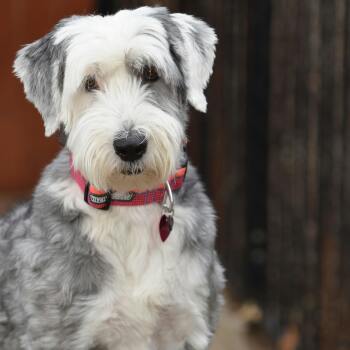Old English Sheepdogs

Old English Sheepdog: Fluffy, Fun, and Full of Personality
With their cloud-like coats and lovable personalities, the Old English Sheepdog—affectionately called the "Sheepie"—is impossible to ignore. They’re the kind of dog that makes every day brighter, every family walk livelier, and every cuddle session a little warmer. If you’ve ever dreamed of having a walking teddy bear as your best friend, this breed may be your perfect match.
What Makes the Sheepie Shine
Sheepdogs are affectionate, outgoing, and always eager to be part of the action. Despite their shaggy, laid-back appearance, they’re alert and confident—always ready to lend their bark to guard the family. They’re playful without being hyper, and they adore kids, making them a standout choice for active households.
Add to that their social nature and clownish sense of humor, and it’s no wonder this breed has been charming dog lovers for centuries. Whether romping in the yard or snoozing on the couch, they’re happiest when surrounded by their people.
Things to Consider Before Bringing One Home
Every breed has its quirks, and the Old English Sheepdog is no exception. They’re herders at heart, and that instinct can come out in unexpected ways—like gently nudging children or chasing after the family cat. They also don’t love being left alone for long and may get into mischief if they’re bored or lonely.
Training can be a bit of a challenge thanks to their independent streak, and their thick coats require consistent grooming. Also, because of their size and full-body fur, Sheepdogs are prone to overheating in warm weather. And yes—prepare for drool and plenty of hair tumbleweeds.
From Working Fields to Family Rooms
Originally bred in England during the 1800s, these dogs helped drive livestock to market. Their iconic shaggy coats and naturally bobbed tails helped identify them as working dogs (and even exempted them from taxes!). Their intelligence and versatility earned them a place not just in pastures, but in hearts and homes around the world.
Today, they’re just as comfortable playing in the backyard as they are competing in agility, obedience, or being a lovable couch companion.
Common Health Concerns for Old English Sheepdogs
- Bloat (GDV)— This large, deep-chested breed is at higher risk for bloat—a life-threatening condition where the stomach twists and traps gas. Symptoms like unproductive retching, restlessness, or a swollen belly require emergency care. Talk to your vet about preventive options like gastropexy surgery.
- Joint & Bone Issues— Osteochondritis dissecans (OCD), hip dysplasia, and elbow dysplasia can affect mobility and cause early-onset arthritis. Managing weight, using joint-supportive diets, and early diagnostic X-rays can help keep your Sheepie moving comfortably.
- Inherited Bleeding Disorders— Sheepdogs are prone to clotting issues like Von Willebrand’s Disease and immune-mediated conditions such as hemolytic anemia and thrombocytopenia. Routine pre-surgical blood tests can detect these issues and help avoid complications.
- Diabetes— Old English Sheepdogs have a higher risk of developing diabetes. If you notice increased thirst, urination, appetite, or unexplained weight loss, don’t wait—blood testing and early treatment can manage the condition long-term with insulin and diet adjustments.
- Wobbler Disease & Neurological Conditions— Balance issues, tremors, or a wobbly gait may signal spinal problems like Wobbler Syndrome. Epilepsy can also occur in this breed. Both require diagnosis and long-term management through medication or therapy.
- Heart Conditions— Dilated cardiomyopathy (DCM) and other structural heart issues can affect this breed. Yearly heart screenings, including ECGs or echocardiograms, can help catch problems early. If your dog seems lethargic or develops a cough, call your vet.
- Eye Problems— Cataracts and eyelid abnormalities like entropion (where the eyelid rolls inward) are common. These can affect comfort and vision. Many conditions are treatable through surgery or medication if caught early during routine exams.
- Liver Concerns (PSS)— Portosystemic shunt (PSS) is a liver disorder that can cause poor growth or even seizures in young dogs. Liver function tests are important before any anesthesia and can help detect this early.
- Cancer— Both lymphoma and osteosarcoma (bone cancer) appear more frequently in this breed than others. Regular wellness visits and lump checks are essential for early detection and better treatment outcomes.
- Bladder & Kidney Stones— If you notice blood in the urine or your Sheepie straining to go, it could indicate a urinary blockage—a medical emergency. Some Sheepdogs are genetically prone to stones, so regular urine testing is recommended.
- Allergies & Skin Conditions— From atopy (environmental allergies) to mange and autoimmune issues like pemphigus, this breed’s sensitive skin needs special care. Look out for signs like paw licking, redness, or hair loss and ask your vet about long-term treatment options.
- Hormonal Imbalances— Old English Sheepdogs may develop Addison’s disease (underactive adrenal glands) or hypothyroidism (underactive thyroid). Both can cause fatigue, hair loss, weight changes, or GI issues—but are usually manageable with daily medication.
Is a Sheepie Right for You?
If you’re looking for a lovable goofball with big energy and even bigger heart, an Old English Sheepdog might just be the perfect fit. Give them the attention and structure they need, and you’ll be rewarded with a fiercely loyal, joy-filled companion.
Ready to Learn More? We’re Here to Help!


